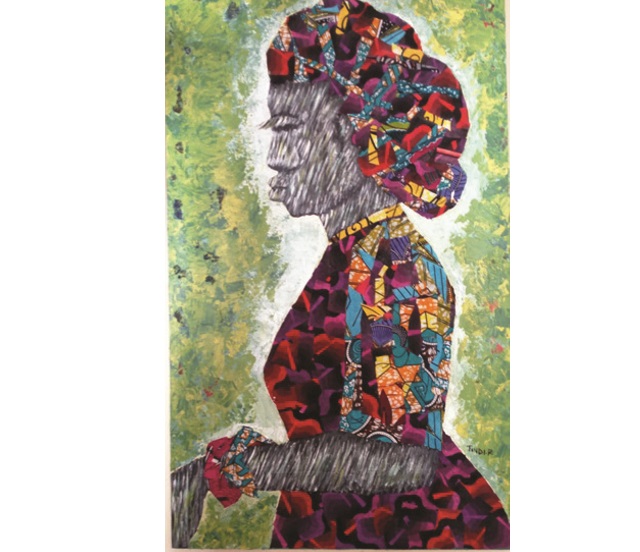
Exhibition tackles Buganda totems and nostalgic paintings
Kampala, Uganda| DOMINIC MUWANGUZI | Githeri is a Kenyan word that loosely means cooking different foods – usually maize and beans – in one bowl. When art borrows the concept, the resukt is a wonderful mixture of different ideas, techniques, styles, themes and diverse reactions. And that is exactly what is on show at AKA Gallery in Kampala under the title:`Githeri Exhibition’. It features three artists; Isa Outarra, Paul Kintu, and Ronnie Tindi.
Ronnie Tindi is no stranger to the media of textile collage and acrylics fused together on the same canvas. The technique imbues his art with myriad textures, patterns and shades (usually bright) that often culminate in vibrant and energetic wall hangings. Additionally, his forte of the African woman motif featured in voluptuous sizes on canvas and dressed in Kitengi fabric evoke feminism and suggest appreciation of the social-economic contribution of the woman.
Tindi’s recent show at AKA gallery in Kampala was in the same mold, concept, and technique. He displayed a series of semi-abstract images of the voluptuous African woman to inspire conversation around Buganda totems.
“I was inspired by a painting I did for my mother and titled it `Namutebi’ which is mother’s name,” says the artist. The artist says that after it was done, he decided to do a series and title each of the paintings a different feminine name from the royal clan. Hence, on show are paintings titled Nalumansi, Namala, Nakirya and Nakabugo to represent the different clans and totems.
This time, however, his textured backgrounds are layered with sometimes monochromic or vibrant hues and he uses recurring fine strokes of the paint brush on the female subject, which infuses the paintings with an unusual catchy attribute.
“It is a new style I am trying to experiment with,” he points out when I ask him to explain why the style is dominant.
In light of the totem theme, Tindi probably is eager to ignite a dialogue on the type of affection different people have towards their clans and totems. He might also be seeking allusions to the idea of conservation and preservation of cultural norms that is manifested in naming of individuals certain names. A name is not only a form of identity but a symbolic gesture that suggests one’s cultural practice or heritage. The notion of employment of the woman figure together with the totem motif is undoubtedly a symbol of love and affection. The woman is most times artistically represented as an icon of beauty and love.
If Tindi is too eager to experiment with new styles and concepts, then Paul Kintu’s semi-abstract drawings will quickly remind you of an artist who is consistent with his artistic identity and is not ready to make that transition into something new. Kintu; a fervent executioner of simple- but not simplistic- paintings in child-like fashion, showcases works that convey a message of day to day life experiences juxtaposed with a glowing palette of yellows and reds.
His images of a couple holding hands, a beauty queen thinking about her lover (In Love 2017) and kids waving at an aircraft (Farewell 2017), do not only rekindle the tradition of yesteryear where artists chose simple themes and made beautiful art out of them, but also suggest the relevance of such topics in an era of experimental art. One painting titled, `Play time 2017’, hanging at the entrance of the gallery is evocative of the playful nature of children coupled with their innocence. The painting has two kids enjoying a ride in a wheelbarrow that is being pushed by their sibling.
Isa Outarra’s functional sculptures with conceptual designs created from metal debris stimulate dialogue on the topic of functionality of art and recycling. The artist sculpts lounge chairs and lamp stands as an alternative to expensive hard wood furniture. His practical artworks are easily compatible in recreational facilities and settings like hotels, country Lodges and homes.
The exhibition opened on July 01 at AKA gallery on Bukoto Street and will remain open until July 29.
****
 The Independent Uganda: You get the Truth we Pay the Price
The Independent Uganda: You get the Truth we Pay the Price





